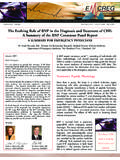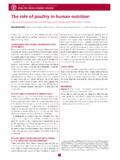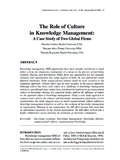Transcription of The Role of Facilitation in Collaborative Groups
1 The Role of Facilitation in Collaborative Groups Sandor P. Schuman An earlier version of this chapter appeared in Chris Huxham, ed., The Search for Collaborative Advantage. London: Sage. Introduction Many Collaborative Groups make use of facilitators as illustrated in Chapters 3, 7, 10, and 11. What exactly is the role of a facilitator and how is it different from the role of the participants? Why are facilitators so concerned about process versus content (as related in Chapter 9)? Under what circumstances should a group consider using a facilitator? A facilitator helps a group to work collaboratively by focusing on the process of how the participants work together.
2 Facilitators apply their expertise in leading the process, but they are not participants, have no authority to impose any action on the group , and have no vested interest in the outcome. To explore this further it will be helpful to compare the role of the facilitator to other roles that pertain to collaboration and conflict resolution as illustrated in Figure 1. The participants, for example, are familiar with the issues and have pertinent knowledge. They are advocates for their own interests, values, preferences and biases. They have opinions and make judgments about what is important and what action should be taken.
3 In situations where the participants cannot resolve a conflict on their own they sometimes bring the problem to a higher authority, typically a government agency or the court system. Here the participants present their differing views to an administrator or judge who ensures that the decision making process is fair, does not have a bias in favor of one party or another, but who does have the authority to make and impose a decision. In such settings (as well as in formal negotiations), the participants often engage lawyers or others to act as advocates on their behalf. These individuals are skilled in the administrative or legal decision making process and use their knowledge on behalf of their clients.
4 In so doing they do not make judgments about their clients or the outcomes they seek. Instead of resorting to formal negotiations, administrative remedies or legal proceedings some Groups try to work out their differences by better understanding each other and working collaboratively to develop consensus. The Collaborative process is complex, and their need for process expertise is great. However, they do not want process experts who will impose their own views or make decisions for them -- the participants already have the necessary knowledge of the issues and want to make their own decisions.
5 Nor do they Copyright 1996, 1999 by Sandor Schuman Executive Decision Services 1. The Role of Facilitation in Collaborative Groups Sandor P. Schuman want advocates who can represent their points of view -- they can advocate on their own behalf. Instead they want assistance in constructing and implementing a process that is fair to all participants, that will ensure high quality communication throughout the group , and that will result, if possible, in creating a solution of their own making to which they agree of their own accord. Providing assistance in managing such a process is the role of the facilitator.
6 Process as a Moral Issue Nearly everyone involved in the practice or theory of group problem solving and decision making seems to share some concern about distinguishing between different aspects of Collaborative work. Distinctions are made between process and content (Eden 1990, Phillips and Phillips 1993), process and structure (Schein 1969), process and outcome (Rohrbaugh 1987), context, content and process (Broome and Keever 1989), and content, process and structure (Schein 1987, Smith 1988). Related distinctions are made between task and maintenance behaviors (Benne and Sheats 1948) and task and interpersonal issues (Schein 1987).
7 A useful way to enlighten this discussion might be to examine why people find these to be important distinctions. One way to view their importance is because these are instrumental issues. With a better understanding and command of these issues, facilitators can design better, more successful Collaborative activities. Another explanation is that these issues are just so fundamental -- they are the means by which problems get solved and decisions made. In democratic systems, the means are the ends. These are moral issues. The way in which collaboration is practiced, including the way that process and content are managed and integrated, is a moral issue, whether or not it is explicitly recognized as such by the participants.
8 Facilitators, and other process consultants who support Collaborative activities, are largely concerned with process issues, and claim, perhaps, to intervene only in process, not in content. How exactly to say this is not a trivial turn of a phrase. Many "process". facilitators recognize that they interpret or influence the content, although they do not contribute to it based on their substantive expertise, but rather based on their analytical expertise. That is, they listen to the participants, ask questions, analyze and integrate the different pieces of information they receive, and feedback the results of their thinking to the participants, perhaps to receive more information or to generate further discussion.
9 This has been described as "handing back in changed form" (Phillips and Phillips 1993). However, by using the singular term process, we give short shrift to the role of the facilitator, and must supplement our description of the facilitator's role by saying that the facilitator delves in some fashion into content. An attempt to address these language distinctions and integrate various terms is presented in Table 1. Copyright 1996, 1999 by Sandor Schuman Executive Decision Services 2. The Role of Facilitation in Collaborative Groups Sandor P. Schuman Table 1: Facilitator influences in Collaborative activities Influence of the Facilitator Aspects of Collaborating Structure Process Content Linear, hierarchical, network, Summarizing; Feedback etc.
10 Cognitive Problem structure Procedures for analytical thinking Social Arrangement of seating and Rules of interpersonal technology communication Political Advice about who should Advice about communicating participate results to non-participants Three Types of Process: Cognitive, Social, and Political. group process has been a concern of social psychology for perhaps thirty years (for example Steiner 1972, McGrath 1984). Process is generally used as a singular term, but its meaning is sometimes confusing, or takes a great deal of effort to explain. Consequently it will be useful to differentiate three types of process: cognitive, social, and political.









